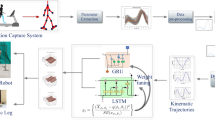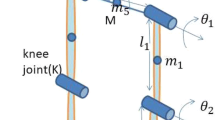Abstract
This paper presents the predictive models for biped robot trajectory generation. Predictive models are parametrizing as a continuous function of joint angle trajectories. In a previous work, the authors had collected the human locomotion dataset at RAMAN Lab, MNIT, Jaipur, India. The MNIT gait dataset consists of walking data on a plane surface of 120 human subjects from different age groups and genders. Thirty-two machine learning models (linear, support vector, k-nearest neighbor, ensemble, probabilistic, and deep learning) trained using the collected dataset. In addition, two types of mapping, (a) one-to-one and (b) many-to-one, are presented for each model. These mapping models act as a reference policy for the control of joints and prediction of state for the next time instant in advance if the onboard sensor fails. Results show that the deep learning and probabilistic learning models perform better for both types of mappings. Also, the probabilistic model outperforms the deep learning-based models in terms of maximum error, because the probabilistic model effectively deals with the prediction uncertainty. In addition, many-to-one outperforms the one-to-one mapping because it captures the correlation between knee, hip, and ankle trajectories. Therefore, this study suggests a many-to-one mapping using the probabilistic model for biped robot trajectory generation.




Similar content being viewed by others
References
Conde, M. A., Rodriguez-Sedano, F. J., Fernandez-Llamas, C., Goncalves, J., Lima, J., & Garcia-Penalvo, F. J. (2021). Fostering STEAM through challenge-based learning, robotics, and physical devices: A systematic mapping literature review. Computer Applications in Engineering Education, 29, 46–65.
Singh, B., Kumar, R., & Singh, V. P. (2021). Reinforcement learning in robotic applications: a comprehensive survey. Artificial Intelligence Review. https://doi.org/10.1007/s10462-021-09997-9
Zheng, T. J., Zhu, Y., Zhang, Z., Zhao, S., Chen, J., & Zhao, J. (2018). Parametric gait online generation of a lower-limb exoskeleton for individuals with paraplegia. Journal of Bionic Engineering, 15, 941–949.
Boudon, B., Linares, J. M., Abourachid, A., Vauquelin, A., & Mermoz, E. (2018). Bio-inspired topological skeleton for the analysis of quadruped kinematic gait. Journal of Bionic Engineering, 15, 839–850.
Gong, Z., Cheng, J., Chen, X., Sun, W., Fang, X., Hu, K., Xie, Z., Wang, T., & Wen, L. (2018). A bio-inspired soft robotic arm: Kinematic modeling and hydrodynamic experiments. Journal of Bionic Engineering, 15, 204–219.
Ma, Y., Fan, X., Cai, J., Tao, J., Gao, Y., & Yang, Q. (2021). Application of sensor data information cognitive computing algorithm in adaptive control of wheeled robot. IEEE Sensors Journal. https://doi.org/10.1109/JSEN.2021.3054058
Ficht, G., & Behnke, S. (2021). Bipedal humanoid hardware design: A technology review. Current Robotics Reports. https://doi.org/10.1007/s43154-021-00050-9
Liu, B., Xiao, X., & Stone, P. (2021). A lifelong learning approach to mobile robot navigation. IEEE Robotics and Automation Letters, 6, 1090–1096.
Pratt, J., Chew, C. M., Torres, A., Dilworth, P., & Pratt, G. (2001). Virtual model control: An intuitive approach for bipedal locomotion. The International Journal of Robotics Research, 20, 129–143.
Golliday, C., & Hemami, H. (1977). An approach to analyzing biped locomotion dynamics and designing robot locomotion controls. IEEE Transactions on Automatic Control, 22, 963–972.
Park, J. H., Chung, H. (1999) ZMP compensation by online trajectory generation for biped robots. In IEEE SMC’99 Conference Proceedings IEEE International Conference on Systems, Man, and Cybernetics (Cat. No. 99CH37028), 4, 960–965.
Hasegawa, Y., Arakawa, T., & Fukuda, T. (2000). Trajectory generation for biped locomotion robot. Mechatronics, 10, 67–89.
Arakawa, T., Fukuda, T. (1996) Natural motion trajectory generation of biped locomotion robot using genetic algorithm through energy optimization. In 1996 IEEE International Conference on Systems, Man and Cybernetics, Information Intelligence and Systems (Cat. No. 96CH35929), 2, 1495–1500.
Suzuki, T., Tsuji, T., Shibuya, M., & Ohnishi, K. (2008). ZMP reference trajectory generation for biped robot with inverted pendulum model by using virtual supporting point. IEEE Transactions on Industry Applications, 128, 687–693.
Kim, J., Ba, D. X., Yeom, H., & Bae, J. (2021). Gait optimization of a quadruped robot using evolutionary computation. Journal of Bionic Engineering, 18, 306–318.
Chen, J., Liu, C., Zhao, H., Zhu, Y., & Zhao, J. (2020). Learning to identify footholds from geometric characteristics for a six-legged robot over rugged terrain. Journal of Bionic Engineering, 17, 512–522.
Juang, C. F., & Yeh, Y. T. (2017). Multi-objective evolution of biped robot gaits using advanced continuous ant-colony optimized recurrent neural networks. IEEE Transactions on Cybernetics, 48, 1910–1922.
Embry, K. R., Villarreal, D. J., Macaluso, R. L., & Gregg, R. D. (2018). Modeling the kinematics of human locomotion over continuously varying speeds and inclines. IEEE Transactions on Neural Systems and Rehabilitation Engineering, 26, 2342–2350.
Clever, D., Hu, Y., & Mombaur, K. (2018). Humanoid gait generation in complex environments based on template models and optimality principles learned from human beings. The International Journal of Robotics Research, 37, 1184–1204.
Riley, M., Ude, A., Wade, K., Atkeson, C. G. (2003) Enabling real-time full-body imitation: A natural way of transferring human movement to humanoids. In 2003 IEEE International Conference on Robotics and Automation (Cat. No. 03CH37422), 2, 2368–2374.
Aithal, C. N., Ishwarya, P., Sneha, S., Yashvardhan, C. N., & Suresh, K. V. (2020). Design of a Bipedal Robot. Advances in VLSI, Signal Processing, Power Electronics, IoT, Communication and Embedded Systems: Select Proceedings of VSPICE, 2021, 752–755.
Prakash, C., Kumar, R., & Mittal, N. (2018). Recent developments in human gait research: Parameters, approaches, applications, machine learning techniques, datasets and challenges. Artificial Intelligence Review, 49, 1–40.
Prakash, C., Gupta, K., Mittal, A., Kumar, R., & Laxmi, V. (2015). Passive marker based optical system for gait kinematics for lower extremity. Procedia Computer Science, 45, 176–185.
Prakash, C., Mittal, A., Kumar, R., Mittal, N. (2015) Identification of spatio-temporal and kinematics parameters for 2-D optical gait analysis system using passive markers. In 2015 International Conference on Advances in Computer Engineering and Applications, 143–149.
Prakash, C., Mittal, A., Tripathi, S., Kumar, R., Mittal, N. (2016) A framework for human recognition using a multimodel gait analysis approach. In 2016 International Conference on Computing, Communication and Automation (ICCCA), 348–353.
Prakash, C., Mittal, A., Kumar, R., Mittal, N. (2015) Identification of gait parameters from silhouette images. In 2015 Eighth International Conference on Contemporary Computing (IC3), 190–195.
Prakash, C., Gupta, K., Kumar, R., Mittal, N. (2016) Fuzzy logic-based gait phase detection using passive markers. In Proceedings of Fifth International Conference on Soft Computing for Problem Solving, Springer, Singapore, 561–572.
Prakash, C., Sujil, A., Kumar, R., Mittal, N. (2019) Linear prediction model for joint movement of lower extremity. In Recent Findings in Intelligent Computing Techniques, Springer, Singapore, 235–243.
Prakash, C., Kumar, R., Mittal, N., & Raj, G. (2018). Vision based identification of joint coordinates for marker-less gait analysis. Procedia Computer Science, 132, 68–75.
Weisberg, S. (2005). Applied linear regression (p. 528). Wiley.
Hoerl, A. E., Kannard, R. W., & Baldwin, K. F. (1975). Ridge regression: Some simulations. Communications in Statistics-Theory and Methods, 4, 105–123.
Marquardt, D. W., & Snee, R. D. (1975). Ridge regression in practice. The American Statistician, 29, 3–20.
Efron, B., Hastie, T., Johnstone, I., & Tibshirani, R. (2004). Least angle regression. Annals of Statistics, 32, 407–499.
Then, Q. (2020). Conversion modeling: Machine learning for marketing decision support (p. 95). Humboldt University of Berlin.
Sun, Q., Zhou, W. X., & Fan, J. (2020). Adaptive huber regression. Journal of the American Statistical Association, 115, 254–265.
Choi, S., Kim, T., & Yu, W. (1997). Performance evaluation of RANSAC family. Journal of Computer Vision, 24, 271–300.
Wilcox, R. (1998). A note on the Theil-Sen regression estimator when the regressor is random and the error term is heteroscedastic. Biometrical Journal: Journal of Mathematical Methods in Biosciences, 40, 261–268.
Zou, H., & Hastie, T. (2005). Regularization, and variable selection via the elastic net. Journal of the Royal Statistical Society: Series B (Statistical Methodology), 67, 301–320.
Pati, Y. C., Rezaiifar, R., Krishnaprasad, P. S. (1993) Orthogonal matching pursuit: recursive function approximation with applications to wavelet decomposition. In Proceedings of 27th Asilomar Conference on Signals, Systems and Computers, 40–44.
Vovk, V. (2013). Kernel ridge regression. In E. Inference (Ed.), Springer (pp. 105–116). Germany.
Drucker, H., Burges, C. J., Kaufman, L., Smola, A., & Vapnik, V. (1997). Support vector regression machines. Advances in Neural Information Processing Systems, 9, 155–161.
Smola, A. J., & Schölkopf, B. (2004). A tutorial on support vector regression. Statistics and Computing, 14, 199–222.
Cheng, D., Zhang, S., Deng, Z., Zhu, Y., Zong, M. (2014) KNN algorithm with data-driven k value. In International Conference on Advanced Data Mining and Applications, Springer, Cham, 499–512.
Chou, P. A. (1991). Optimal partitioning for classification and regression trees. IEEE Computer Architecture Letters, 13, 340–354.
Breiman, L. (2001). Random forests. Machine Learning, 45, 5–32.
Schapire, R. E. (2010). The convergence rate of AdaBoost. In COLT, 10, 308–309.
Zemel, R. S., Pitassi, T. (2001) A. gradient-based boosting algorithm for regression problems. In: Advances in Neural Information Processing Systems, 696–702.
Raftery, A. E., Madigan, D., & Hoeting, J. A. (1997). Bayesian model averaging for linear regression models. Journal of the American Statistical Association, 92, 179–191.
Park, T., & Casella, G. (2008). The Bayesian lasso. Journal of the American Statistical Association, 103, 681–686.
Schulz, E., Speekenbrink, M., & Krause, A. (2018). A tutorial on gaussian process regression: Modelling, exploring, and exploiting functions. Journal of Mathematical Psychology, 85, 1–16.
Burt, D., Rasmussen, C. E., Van Der Wilk, M. (2019) Rates of convergence for sparse variational Gaussian process regression. In International Conference on Machine Learning, 862–871.
Thimm, G., & Fiesler, E. (1997). High-order and multilayer perceptron initialization. IEEE Transactions on Neural Networks, 8, 349–359.
Murtagh, F. (1991). Multilayer perceptrons for classification and regression. Neurocomputing, 2, 183–197.
Hinton, G. E., Osindero, S., & Teh, Y. W. (2006). A fast-learning algorithm for deep belief nets. Neural Computation, 18, 1527–1554.
Liu, W., Wang, Z., Liu, X., Zeng, N., Liu, Y., & Alsaadi, F. E. (2017). A survey of deep neural network architectures and their applications. Neurocomputing, 234, 11–26.
Gallicchio, C. (2018) Short-term memory of deep rnn. arXiv preprint https://arxiv.org/abs/1802.00748. Accessed 2 Feb 2018.
Greff, K., Srivastava, R. K., Koutník, J., Steunebrink, B. R., & Schmidhuber, J. (2016). LSTM: A search space odyssey. IEEE Transactions on Neural Networks and Learning Systems, 28, 2222–2232.
Chung, J., Gulcehre, C., Cho, K., Bengio, Y. (2014) Empirical evaluation of gated recurrent neural networks on sequence modeling. arXiv preprint https://arxiv.org/abs/1412.3555. Accessed 11 Dec 2014.
Huang, Z., Xu, W., Yu, K. (2015) Bidirectional LSTM-CRF models for sequence tagging. arXiv preprint https://arxiv.org/abs/1508.01991. Accessed 9 Aug 2015.
Sheng, H., Xiao, J., Cheng, Y., Ni, Q., & Wang, S. (2017). Short-term solar power forecasting based on weighted Gaussian process regression. IEEE Transactions on Industrial Electronics, 65, 300–308.
Funding
None.
Author information
Authors and Affiliations
Corresponding author
Ethics declarations
Conflict of interest
All authors certify that they have no affiliations with or involvement in any organization or entity with any financial interest or non-financial interest in the subject matter or materials discussed in this manuscript.
Ethics approval and consent to participate
Not applicable.
Additional information
Publisher's Note
Springer Nature remains neutral with regard to jurisdictional claims in published maps and institutional affiliations.
Rights and permissions
About this article
Cite this article
Singh, B., Vijayvargiya, A. & Kumar, R. Kinematic Modeling for Biped Robot Gait Trajectory Using Machine Learning Techniques. J Bionic Eng 19, 355–369 (2022). https://doi.org/10.1007/s42235-021-00142-4
Received:
Revised:
Accepted:
Published:
Issue Date:
DOI: https://doi.org/10.1007/s42235-021-00142-4




